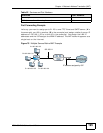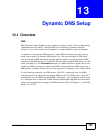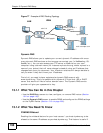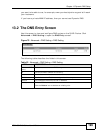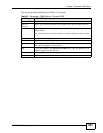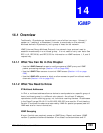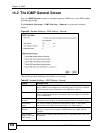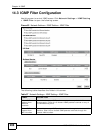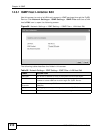
VSG1435-B101 Series User’s Guide
203
CHAPTER 14
IGMP
14.1 Overview
Traditionally, IP packets are transmitted in one of either two ways - Unicast (1
sender to 1 recipient) or Broadcast (1 sender to everybody on the network).
Multicast delivers IP packets to just a group of hosts on the network.
IGMP (Internet Group Multicast Protocol) is a network-layer protocol used to
establish membership in a multicast group - it is not used to carry user data. See
RFC 1112, RFC 2236, and RFC 3376 for information on IGMP versions 1, 2, and 3
respectively.
14.1.1 What You Can Do in this Chapter
•Use the IGMP General screen to configure general IGMP proxy and IGMP
packet processing settings (Section 14.2 on page 206).
•Use the IGMP Filter screens to control IGMP access (Section 14.3 on page
208).
•Use the IGMP ACL screens to block or allow access to specific multicast media
channels (Section 14.4 on page 213).
14.1.2 What You Need to Know
IP Multicast Addresses
In IPv4, a multicast address allows a device to send packets to a specific group of
hosts (multicast group) in a different sub-network. A multicast IP address
represents a traffic receiving group, not individual receiving devices. IP addresses
in the Class D range (224.0.0.0 to 239.255.255.255) are used for IP multicasting.
Certain IP multicast numbers are reserved by IANA for special purposes (see the
IANA web site for more information).
IGMP Snooping
A layer-2 switch can passively snoop on IGMP Query, Report and Leave (IGMP
version 2) packets transferred between IP multicast routers/switches and IP



